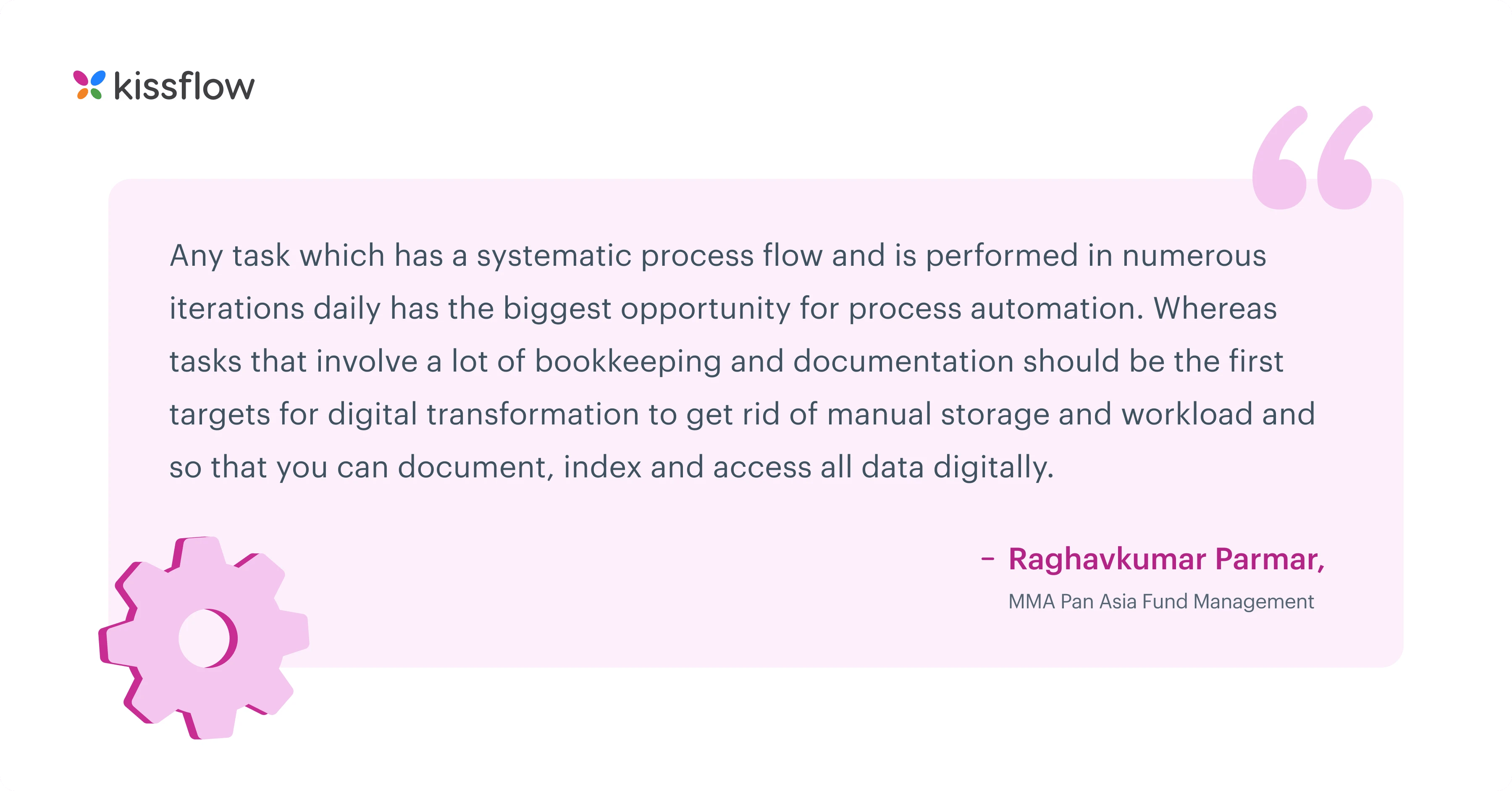
- >
- BPM Software >
- Process vs. Procedure: What Are The Key Differences
Process vs. Procedure: What Are The Key Differences
Every enterprise depends on its processes to achieve objectives and maintain smooth operations. However, the risks are evident, with nearly 40 percent of business processes undocumented and 76 percent of companies experiencing significant challenges due to poor documentation. Poorly documented processes lead to implementation errors, oversight issues, and weakened internal controls.
While CIOs often set ambitious targets and milestones, many need more clarity on the steps required to reach them. Differentiating between processes and procedures is essential to address this gap. Processes define the broader framework, while procedures outline specific actions, ensuring clarity, accountability, and improved knowledge sharing. Understanding these differences enhances operational efficiency and supports compliance and business growth.
What is a process?
In a business context, a process is a structured series of tasks or activities performed sequentially to achieve a specific objective. Processes act as the backbone of an organization, connecting various functions and ensuring that operations flow toward desired outcomes. They establish a framework for consistency and scalability, defining what to do without dictating how to execute each task.
Processes are dynamic, adapting to the business needs. They focus on results, emphasizing the completion of broader objectives, such as improving customer satisfaction, meeting compliance requirements, or achieving operational efficiency. This adaptability makes processes crucial in environments that demand agility, such as scaling operations or responding to market changes.
Real-world examples of processes in business
Processes are the backbone of operations across industries. They ensure activities are structured, repeatable, and aligned with organizational goals. Below are detailed examples of key business process management, highlighting their components and value:

1. Materials procurement
The materials procurement process plays a vital role in supply chain management. It ensures the efficient sourcing of raw materials or goods while maintaining a balance between cost, quality, and timely delivery.
Key steps:
-
Identifying material requirements.
-
Sourcing potential suppliers and sending out requests for quotes.
-
Evaluating bids and negotiating terms.
-
Issuing purchase orders.
-
Receiving materials and verifying quality.
-
Processing payments and managing supplier records.
Benefits:
-
Avoids production delays caused by material shortages.
-
Ensures cost-effective purchasing through supplier comparison.
-
Enhances supplier relationships by providing clear expectations.
2. Employee onboarding
A structured employee onboarding process helps integrate new hires into the organization, improving retention and reducing ramp-up time.
Key steps:
-
Offering a formal welcome and providing an introduction to company culture.
-
Setting up new employee accounts, equipment, and software access.
-
Scheduling orientation and training sessions.
-
Assigning mentors or buddies for guidance.
-
Conducting performance reviews during the onboarding period.
Benefits:
- Ensures employees quickly adapt to their roles.
- Reduces errors by standardizing access to necessary tools and systems.
- Enhances employee satisfaction by providing a clear support framework.
3. Customer complaints management
Managing customer complaints ensures a better customer experience and maintains brand loyalty. This process focuses on resolving issues swiftly and tracking recurring problems for improvement.
Key steps:
-
Receiving and logging customer complaints via various channels (email, phone, chat).
-
Acknowledging receipt and providing an estimated resolution time.
-
Assigning complaints to the relevant teams for investigation.
-
Resolving the issue and communicating the solution to the customer.
-
Capturing feedback to evaluate the customer’s satisfaction.
Benefits:
-
Builds customer trust by handling issues transparently.
-
Identifies root causes of complaints for long-term improvement.
-
Enhances brand reputation through proactive resolution efforts.
4. Claims processing
This process is vital for insurance companies, healthcare providers, and financial services firms. It ensures accurate and timely claim evaluation while maintaining regulatory compliance.
Key steps:
-
Receiving the claim application.
-
Verifying the details provided by the claimant.
-
Evaluating eligibility against policy terms.
-
Calculating claim amounts and authorizing payments.
-
Communicating the claim outcome to the claimant.
Benefits:
-
Reduces processing time, improving claimant satisfaction.
-
Ensures compliance with policy terms and regulatory requirements.
-
Prevents fraud by introducing verification checkpoints.
5. Asset management
The asset management process helps organizations track and maintain physical and digital assets effectively, ensuring optimal utilization and longevity.
Key steps:
-
Identifying and tagging new assets upon acquisition.
-
Logging assets in an asset management system.
-
Scheduling routine maintenance or inspections.
-
Recording usage and wear-and-tear data.
-
Retiring or disposing of assets responsibly.
Benefits:
-
Prevents loss or theft by maintaining accurate records.
-
Optimizes usage by monitoring asset lifecycles.
-
Reduces costs through preventative maintenance strategies.
Benefits of processes in business automation

Enhancing efficiency
Automation eliminates repetitive and manual tasks, allowing employees to focus on higher-value activities. By replacing manual workflows with automated systems, bpm can save business time, reduce delays, and maintain faster throughput. For example, automated data collection can handle tasks that take employees hours to complete, ensuring that operations proceed without interruptions.
Reducing errors
Manual processes often lead to inconsistencies and mistakes due to human oversight. Automation minimizes this risk by following predefined rules and logic. For instance, an automated system evaluates every expense approval request uniformly, reducing financial errors and policy violations. This approach builds trust and enhances reliability in organizational workflows.
Increasing scalability
Automated processes handle growing workloads efficiently without demanding proportional increases in resources. This scalability is critical for businesses experiencing rapid growth or seasonal spikes in demand. For example, a company with an automated order processing system can handle thousands of additional requests without hiring more staff or risking delays.
Improving operational consistency and effectiveness
Automation standardizes tasks, ensuring consistent execution of every process regardless of who is involved. This standardization is key to achieving predictable outcomes, maintaining quality, and adhering to compliance requirements. For example, automating compliance checks ensures every transaction or operation aligns with regulations, reducing the risk of penalties or oversight failures.
Enhancing decision-making
Automated processes often integrate data collection and analysis, giving leaders real-time insights to make informed decisions. For instance, an automated inventory management system tracks stock levels and analyzes trends to predict future demand, enabling proactive decision-making.
Boosting employee satisfaction
Automation reduces the burden of mundane tasks, empowering employees to focus on creative and strategic work. This shift improves job satisfaction and productivity as workers dedicate their time to meaningful contributions rather than routine tasks.
Real-world impact:
-
Customer Service: Automated ticketing systems enhance response times and address every customer query without oversight.
-
Manufacturing: Automation ensures consistent production quality and reduces waste.
-
Finance: Automated invoicing and payroll systems minimize discrepancies and delays.
What is a procedure?
A procedure is a detailed and structured set of instructions outlining the steps required to complete a specific task or activity. While processes focus on achieving broader business outcomes, procedures delve into the granular actions employees must follow to ensure consistency and accuracy in task execution. Procedures are inherently authoritarian, leaving little room for ambiguity, which makes them essential for tasks requiring precision and adherence to standards.
Benefits of procedures
Ensuring consistency
Documented procedures ensure employees perform tasks uniformly, essential for repetitive or high-stakes activities. Clear guidelines eliminate variability in execution. Paired with automation, workflows based on procedures deliver consistent outcomes. For instance, an automated payroll system ensures timely, error-free salary processing while supporting brand alignment.
Improving task accuracy
Errors in task execution are costly. Step-by-step procedures reduce ambiguity, enabling employees to complete tasks accurately. Automation further enhances accuracy by minimizing human intervention in repetitive processes. For example, automated quality control systems detect defects consistently, ensuring high-quality results based on pre-defined criteria.
Simplifying training for repetitive tasks
Training new employees can be time-intensive, but clear procedures simplify onboarding with comprehensive guidance. Employees quickly grasp processes through these guidelines and observe workflows supported by automation. Procedures stored on digital platforms allow self-paced training and preserve institutional knowledge for consistent task performance.
Real-world Impact of Procedures in Automation
-
Customer Support: Automated ticketing systems use documented procedures to categorize, assign, and resolve support tickets, ensuring consistent and timely responses.
-
Manufacturing: Workflow automation based on quality control procedures maintains product standards and reduces production defects.
-
Healthcare: Documented medical procedures integrated into automated systems ensure compliance with strict regulations, safeguarding patient safety.
Key differences between process and procedure in business
Processes and procedures are essential to business operations, each serving a distinct purpose to ensure efficiency and clarity. A process outlines a sequence of interconnected tasks that achieve a specific objective, such as completing a sale, onboarding an employee, or managing procurement. Processes define the broader framework by focusing on what needs to happen and why it is important. For example, a sales process includes stages like lead generation, qualification, quoting, and deal closure. Processes remain adaptable, allowing businesses to adjust strategies and workflows in response to evolving goals or market conditions.
A procedure, in contrast, provides step-by-step instructions that detail how to complete individual tasks within a process. Procedures emphasize precision, consistency, and compliance, guiding actions to ensure tasks meet established standards. For instance, a procedure within the sales process explains how to input customer data into a CRM system or generate an invoice. Unlike processes, procedures remain rigid to prioritize accuracy and repeatability.
Processes maintain flexibility and enable organizations to adapt to new strategies or external changes, such as introducing innovative customer engagement tools. Procedures focus on standardization, ensuring tasks remain consistent and aligned with quality requirements. This distinction proves critical for activities like regulatory reporting or system configurations, where precision takes precedence.
Processes and procedures work together to bridge high-level objectives with operational execution. Processes provide the framework and direction, while procedures guide the actions necessary to achieve those goals. For example, an employee onboarding process involves multiple stages, such as orientation and training, to integrate new hires. Procedures within this process, like setting up email accounts or assigning training schedules, ensure every step occurs smoothly and effectively.
Processes focus on the "what" and "why" by targeting goals and promoting adaptability, while procedures concentrate on the "how" to ensure consistent and effective task execution. This clarity allows organizations to align strategic objectives with day-to-day activities, creating a cohesive and efficient workflow that drives success.
Learn more: Process automation solutions
Example of Process vs. Procedure
A large e-commerce company's processes and procedures are crucial to streamline operations.
For instance, the order fulfillment process outlines the many stages of successfully fulfilling incoming orders. The process ideally includes:
1- Receiving orders
2- Processing orders
3- Managing inventory
4- Picking and packing products
5- Shipping
6- Tracking order
7- Providing customer service
8- Managing returns and refunds
On the other hand, order fulfillment procedures include detailed instructions on how employees should perform different tasks and manage specific situations.
For example, the procedure for picking and packing products include:
1- Retrieving order information
2- Selecting orders from the warehouse
3- Selecting the right packaging material and packing up the products to avoid any damage
4- Generating invoices, shipping labels, and barcodes
5- Conducting final quality check before shipping the products
Building world-class processes with Kissflow
Businesses must align processes with organizational goals and adapt to evolving demands to stay competitive and drive profitability. Kissflow’s low-code platform empowers teams to design, automate, and manage workflows precisely and efficiently. Its intuitive interface and drag-and-drop builder enable users to create and customize workflows without heavy IT involvement. Businesses can simplify workflows, boost productivity, and ensure consistent results by automating repetitive tasks and organizing complex operations across departments. Solve your workflow challenges with Kissflow platform and optimize your team's productivity.
Kissflow enhances agility by offering real-time tracking and the ability to adjust workflows as business needs evolve. Teams can address inefficiencies, eliminate bottlenecks, and maintain operational effectiveness. The platform ensures workflows remain adaptable and future-ready with features like audit trails for compliance and real-time insights to support faster decision-making. Kissflow helps organizations simplify complex processes, respond to change efficiently and achieve sustainable growth by facilitating continuous improvement.
Frequently Asked Questions (FAQs)
1. How do processes and procedures differ?
-
Processes define what work is done and why. They provide a high-level overview of the flow of activities that deliver value to customers or the business. They focus on goals, outcomes, and roles.
-
Procedures define how each task is performed. They offer detailed, step-by-step instructions for executing specific activities within a process. They focus on precision, consistency, and compliance.
2. How does automation impact processes and procedures?
-
For processes, automation:
-
Enhances end-to-end visibility
-
Enables data-driven improvements
-
Allows scaling without proportional increase in workforce
-
-
For procedures, automation:
-
Ensures compliance and consistency
-
Reduces human errors
-
Converts repetitive tasks into rule-based workflows
-
💡 Automation transforms manual instructions into dynamic, adaptable workflows that support continuous improvement.
3. What industries rely more on procedures than processes?
Industries that demand strict compliance and operational safety prioritize procedures:
-
Aviation – Pre-flight and emergency checklists
-
Nuclear energy – Reactor operation protocols
-
Pharmaceuticals – GMP (Good Manufacturing Practice) procedures
-
Food production – HACCP and safety inspections
-
Healthcare – Treatment protocols and surgical checklists
4. Why does confusing processes and procedures hurt automation programs?
Processes describe end-to-end outcomes; procedures describe step-by-step execution. If teams automate procedures without understanding the process goal, workflows become rigid and misaligned with business objectives.
5. How does BPM clarify the difference in practice?
BPM models define the full process outcome and then structure procedures inside it, ensuring automation supports the bigger objective.
6. Which should CIOs optimize first—process or procedure?
Process first. Optimizing procedures without fixing a broken process only improves speed of the wrong flow.
7. How does automation handle procedures within processes?
Procedures become standardized tasks or subflows routed automatically based on process logic.
8. How can teams detect when a procedure is overcomplicating a process?
When steps multiply without improving outcomes, or when approvals/reviews repeat unnecessarily.
Streamline your Business Process with Kissflow
Related Articles










